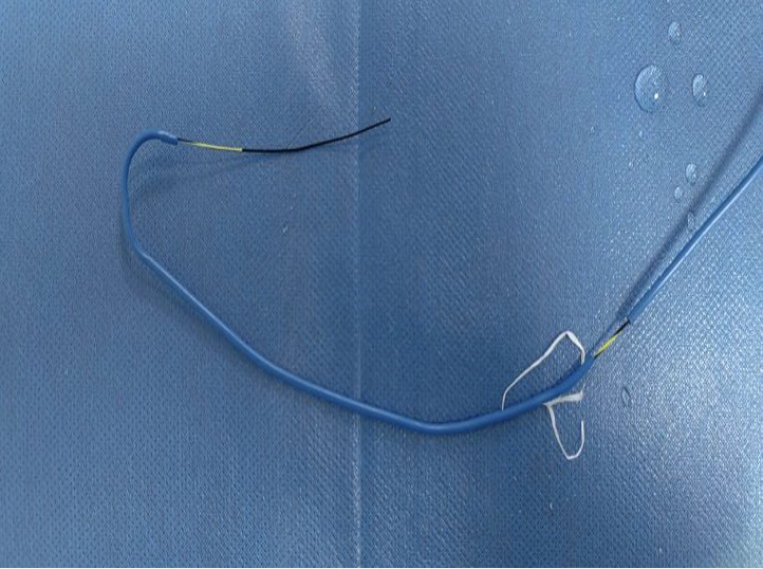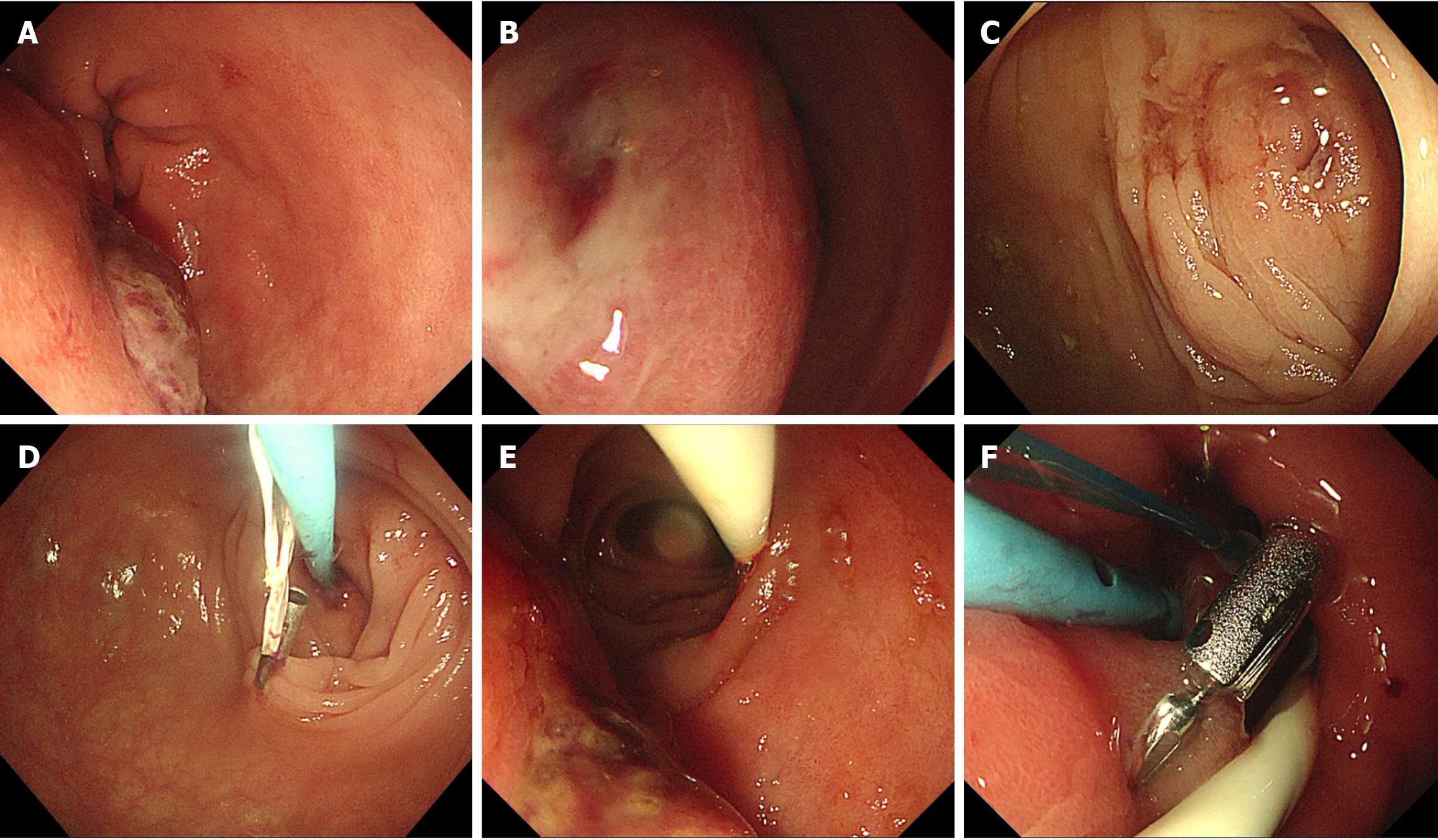Published online Jul 6, 2024. doi: 10.12998/wjcc.v12.i19.3931
Revised: April 22, 2024
Accepted: May 14, 2024
Published online: July 6, 2024
Processing time: 129 Days and 19.8 Hours
Postoperative abdominal infections are an important and heterogeneous health challenge. Many samll abdominal abscesses are resolved with antibiotics, but larger or symptomatic abscesses may require procedural management.
A 65-year-old male patient who suffered operation for the left hepatocellular carcinoma eight months ago, came to our hospital with recurrent abdominal pain, vomit, and fever for one month. Abdominal computed tomography showed that a big low-density dumbbell-shaped mass among the liver and intestine. Colo
The special stent device could be effectively for draining the abdominal abscess respectively from colon and duodenum.
Core Tip: Postoperative abdominal infections are an important and heterogeneous health challenge. Many samll abdominal abscesses are resolved with antibiotics, but larger or symptomatic abscesses may require procedural management. The special stent device could be effectively for draining the abdominal abscess respectively from colon and duodenum.
- Citation: Zhang FL, Xu J, Jiang YH, Zhu YD, Wu QN, Shi Y, Zhan ZY, Wang H. Special stent for draining the abdominal abscess respectively from colon and duodenum: A case report. World J Clin Cases 2024; 12(19): 3931-3935
- URL: https://www.wjgnet.com/2307-8960/full/v12/i19/3931.htm
- DOI: https://dx.doi.org/10.12998/wjcc.v12.i19.3931
Postoperative abdominal infections are an important and heterogeneous health challenge[1]. Many samll abdominal abscesses are resolved with antibiotics, but larger or symptomatic abscesses may require procedural management[2]. We report a case that the special stent device could be effectively for draining the abdominal abscess respectively from colon and duodenum.
A 65-year-old male patient came to our hospital with recurrent abdominal pain, vomit and fever for one month.
The patient was suffered operation for the left hepatocellular carcinoma eight months ago.
The patient was suffered hypertension for ten years.
All other personal and family medical history was normal.
Diseased liver face, no yellowing of the skin or sclera, clear breath sounds on both lungs auscultation, no dry or wet rales, heart rate of 86 beats/min, regular heart rhythm. About 20 cm surgical scar can be saw on the above of abdomen. Upper abdominal tenderness was found and there was no edema in either lower limb.
The laboratory result showed white blood cell, platelet, alanine aminotransferase, glucose, triglyceride, cholesterol, amylase, lipase and alpha-fetoprotein were in normal range (Table 1). Hemoglobin, total bilirubin, creatinine, C-reactive protein, prothrombin time and dimer were not in normal (Table 1). Hepatitis B surface antigen, hepatitis C antibody, human immunodefciency virus antibody, syphilis antibody, anti-nuclear anti-bodies were all negative.
| Laboratory result | Normal | |
| WBC (109/L) | 5.53 | (3.4-9.5) |
| HB (g/L) | 91 | (115-150) |
| Platelet (109/L) | 148 | (125-350) |
| PT(S) | 15.0 | (9.7-13.5) |
| Dimer (mg/L) | 6.41 | (0.00-0.55) |
| ALT (μ/L) | 27 | (9-50) |
| TB (umol/L) | 28.34 | (3-20) |
| Cr (umol/L) | 47 | (40-80) |
| AFP (μg/L) | 5.55 | (0-9) |
| CRP (mg/L) | 171 | (0-10) |
| Triglyceride (mmol/L) | 1.65 | (0-1.7) |
| Cholesterol (mmol/L) | 3.10 | (2.86-5.98) |
| Amylase (U/L) | 131 | (35-135) |
| Lipase (U/L) | 170 | (0-190) |
| Glucose (mmol/L) | 5.2 | 3.0-6.1 |
| HbsAg | Negative | Negative |
| HIV Ab | Positive | Negative |
| Sp Ab | Negative | Negative |
| ANA | Negative | Negative |
| HC Ab | Negative | Negative |
Abdominal computed tomography (CT) showed that a big low-density dumbbell-shaped mass among the liver and intestine (Figure 1A). One day after operation, CT showed that the low-density mass was reduced (Figure 1B). The length of special stent was 20cm and connecting with a dental floss coil at the end of stent. The special stent was cut from the front of a nasobiliary duct [I type F7, 2500 mm, 20212140184, XinChang (ShangHai) Co., Ltd, China] which had multihole hook-shaped drainage, and the another rest long-duct was as a pusher (Figure 2). Gastroscopy showed a big rupture (Figure 3A) on the submucosal mass at the descending duodenum and a fistula (Figure 3B) at the duodenal bulb. Colonoscopy showed a submucosal mass with a fistula (Figure 3C) at colon of liver region.
Gastroscopy showed a big rupture on the submucosal mass at the descending duodenum and a fistula at the duodenal bulb. Colonoscopy showed a submucosal mass with a fistula at colon of liver region. There was no infection found except the abdominal mass.
Under colonoscopy, the brown liquid and pus were drained from the mass with “special stent device”. At first, we pushed the zebra wire [AG-5041-354, 4500mm, Anjie (Hangzhou) Co., Ltd, China] into the fistula, and the special stent was pushed into fistula ahout 10cm with the pusher (the rest long-duct), then the duct was fastened to the peripheral mucosa with a clip [ROCC-D-26-195-C, MMAD230208236, Micro-Tech (Nanjing) Co., Ltd, China] and a dental floss coil (Figure 3D). We could see the drainage form the mass through the hole of stent (Video 1). Under gastroscopy, we retained a nasojejunal nutrient tube [II type 8.5F-G, 2600 mm, 20182660136, Xinchang (Shanghai) Co., Ltd, China] to jejunum (Figure 3E) at first, and then we closed the rupture of the mass with a loop [Loop-30, 080301220409, LeAo (Changzhou) Co., Ltd, China] and six clips [ROCC-D-26-195-C, MMAD230208236, Micro-Tech (Nanjing) Co., Ltd, China] for purse stitching at the descending duodenum, and the same method as colonoscopy was used to drain the brown liquid and pus from the mass (Figure 3F).
The patient's symptom of abdominal pain, vomit, and fever were relieved after the treatment. One day after operation, CT showed that the low-density mass was reduced (Figure 1B).
Abdominal abscess is usually a consequence of surgery, inflammatory bowel disease, diverticulum abscess or ischaemic colitis. It is a condition with high rates of morbidity and mortality[3,4]. Postoperative intra-abdominal abscess is a postoperative collection of infected fluid within the intrabdominal cavity. It is usually treated by a combination of interventional measures and anti-infective therapy[5]. Exact criteria for drainage of an abscess are not standardized. Surgical intervention in intra-abdominal abscesses is rare and usually follows ineffective interventional treatment[6].
In this case, we used special stent device to drain the fliud of the abdominal abscess respectively from colon and duodenum. Compared to the other treatments, The special stent device had the following advantages: (1) It could draining abdominal infectious fluid respectively from the colon and duodenum; (2) The hook-shape could fasten the head of the stent in the mass; (3) The multihole of the stent could drain the bile and other fluid; and (4) The clip and dental floss coil could fasten the stent to mucosa.
The special stent device could be effectively for draining the abdominal abscess respectively from colon and duodenum.
| 1. | Bassetti M, Eckmann C, Giacobbe DR, Sartelli M, Montravers P. Post-operative abdominal infections: epidemiology, operational definitions, and outcomes. Intensive Care Med. 2020;46:163-172. [RCA] [PubMed] [DOI] [Full Text] [Cited by in Crossref: 13] [Cited by in RCA: 44] [Article Influence: 7.3] [Reference Citation Analysis (0)] |
| 2. | Svetanoff WJ, Talukdar N, Dekonenko C, Dorman RM, Osuchukwu O, Fraser JD, Oyetunji TA, St Peter SD. Intra-abdominal Abscess After Appendectomy-Are Drains Necessary in All Patients? J Surg Res. 2020;254:384-389. [RCA] [PubMed] [DOI] [Full Text] [Cited by in Crossref: 5] [Cited by in RCA: 5] [Article Influence: 1.0] [Reference Citation Analysis (0)] |
| 3. | Liu S, Tian Z, Jiang Y, Mao T, Ding X, Jing X. Endoscopic ultrasound-guided drainage to abdominal abscess: A systematic review and meta-analysis. J Minim Access Surg. 2022;18:489-496. [RCA] [PubMed] [DOI] [Full Text] [Cited by in RCA: 2] [Reference Citation Analysis (0)] |
| 4. | Ryan RS, McGrath FP, Haslam PJ, Varghese JC, Lee MJ. Ultrasound-guided endocavitary drainage of pelvic abscesses: technique, results and complications. Clin Radiol. 2003;58:75-79. [RCA] [PubMed] [DOI] [Full Text] [Cited by in Crossref: 34] [Cited by in RCA: 22] [Article Influence: 1.0] [Reference Citation Analysis (0)] |
| 5. | Montravers P, Blot S, Dimopoulos G, Eckmann C, Eggimann P, Guirao X, Paiva JA, Sganga G, De Waele J. Therapeutic management of peritonitis: a comprehensive guide for intensivists. Intensive Care Med. 2016;42:1234-1247. [RCA] [PubMed] [DOI] [Full Text] [Cited by in Crossref: 50] [Cited by in RCA: 59] [Article Influence: 6.6] [Reference Citation Analysis (0)] |
| 6. | Zhao N, Li Q, Cui J, Yang Z, Peng T. CT-guided special approaches of drainage for intraabdominal and pelvic abscesses: One single center's experience and review of literature. Medicine (Baltimore). 2018;97:e12905. [RCA] [PubMed] [DOI] [Full Text] [Full Text (PDF)] [Cited by in Crossref: 17] [Cited by in RCA: 25] [Article Influence: 3.6] [Reference Citation Analysis (0)] |











